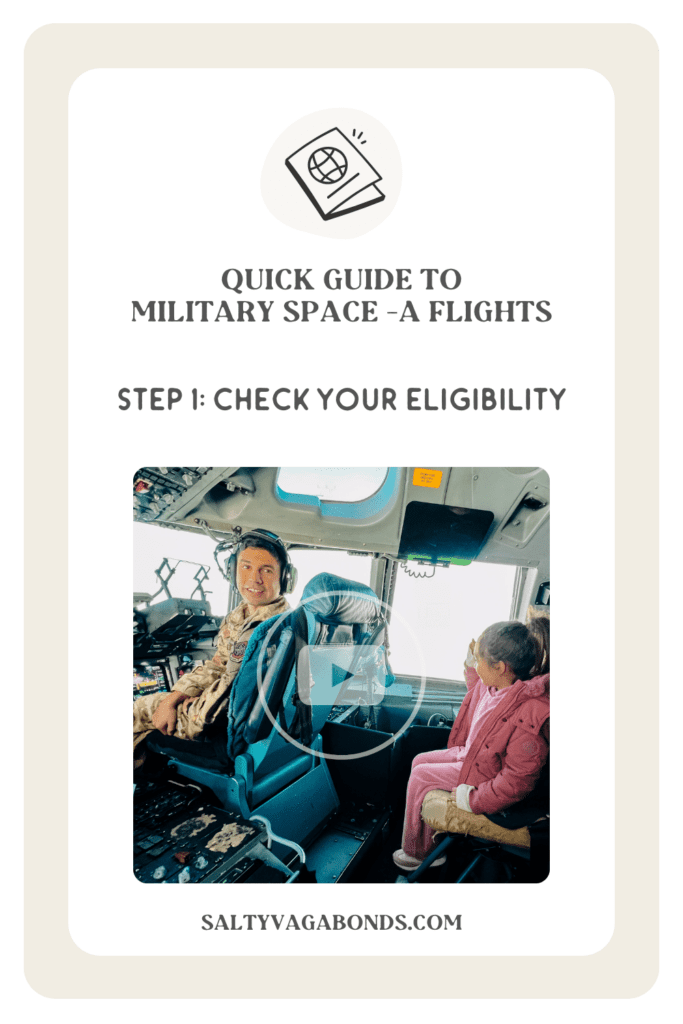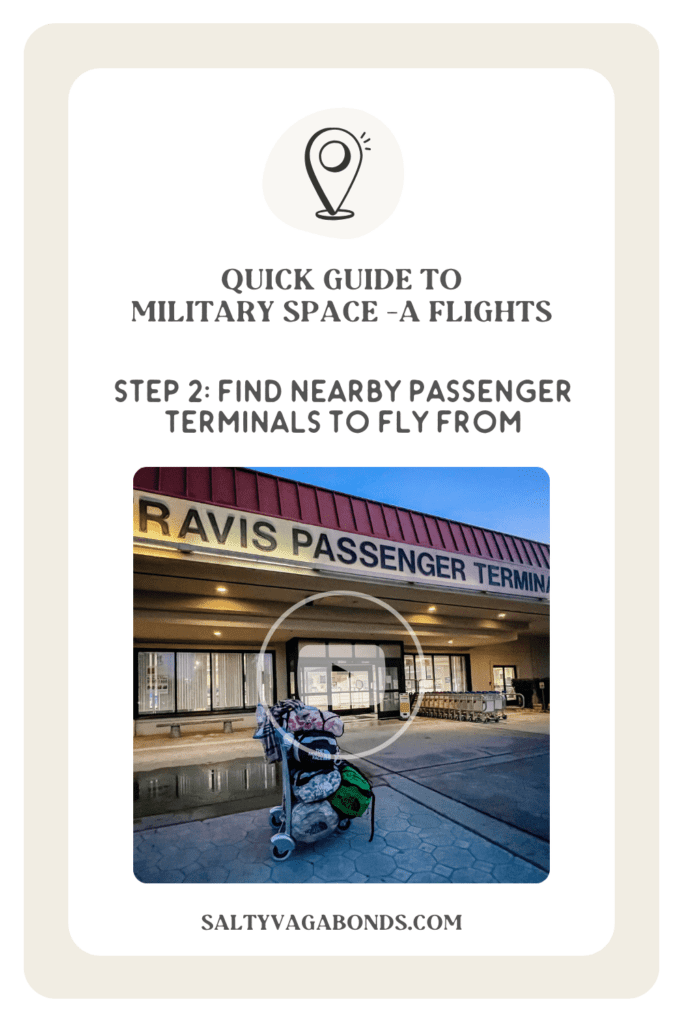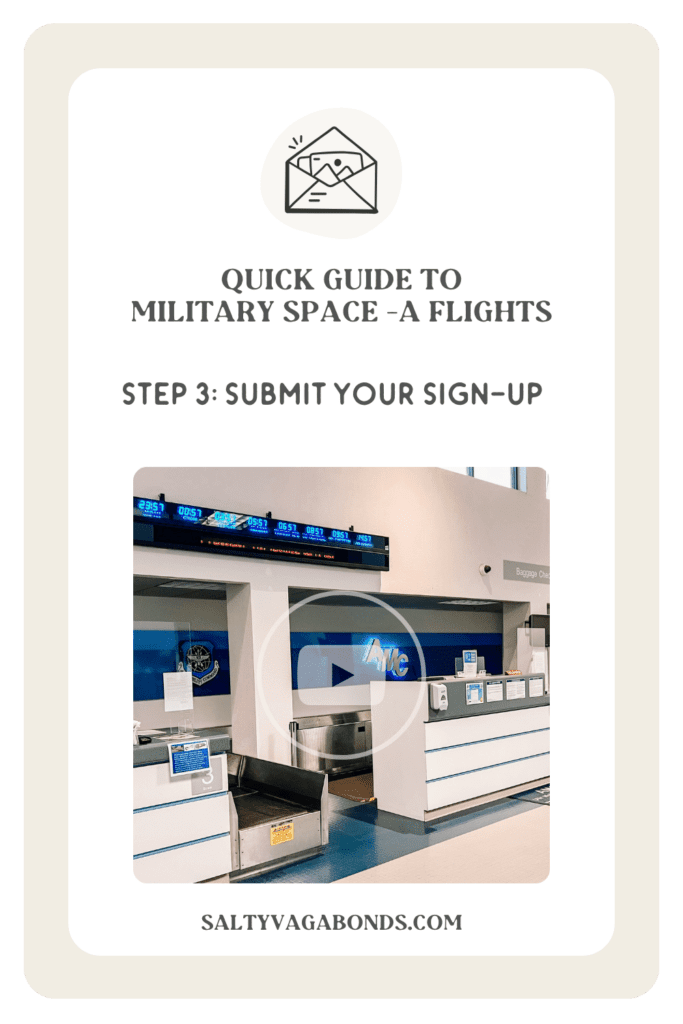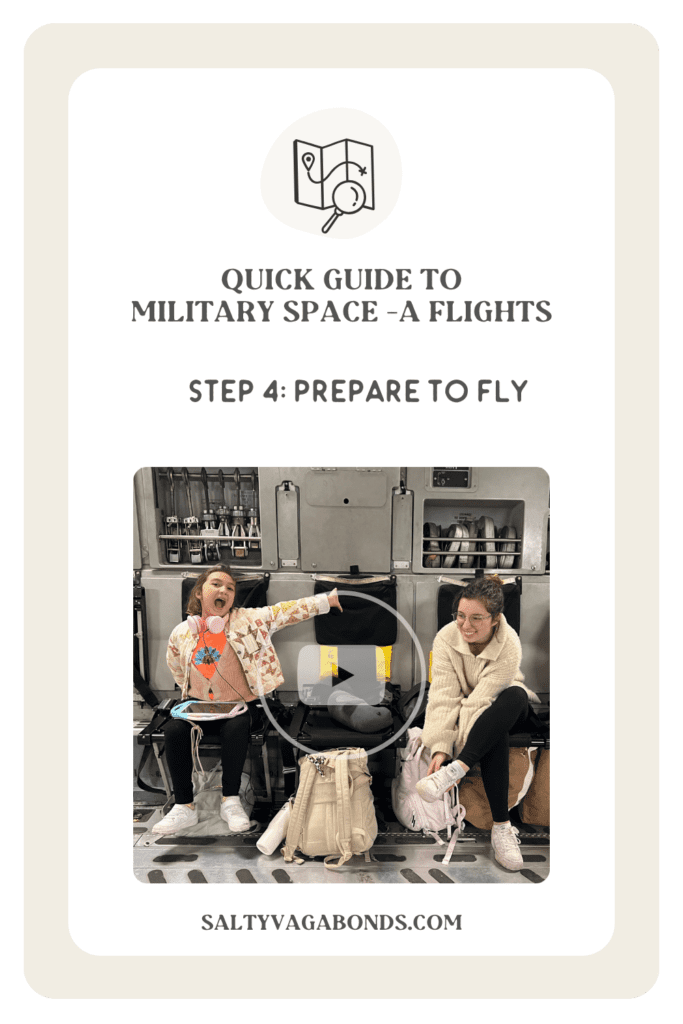
How to Fly Military Space Available (Space-A) Flights Guide
You want to fly for free utilizing military hops but all the information is either overwhelming or scattered all over the place? I created this guide for you so that you’re able to take your first hop with confidence. Let’s take the stress out of it so you can use those military benefits to travel the world.
saltyvagabonds
Destinations
Travel Tips
Planning
About us
Saltyvagabonds
Quickstart Guide to Military Space-A Flights
Here is a quick 4 step guide to get you started. Each photo is linked to a video where I explain exactly what you need to do in each step. If you’d like to watch my entire playlist on the space-available travel program click HERE. Otherwise this guide is broken into a few sections to get you started.
Step 1: Check Your Eligibility.
First Step, you’ll want to make sure you understand your category placement. You can take a deeper dive into your specific category here to see a complete listing of eligible members of the military community that are authorized to fly.
Space-A passengers fall into six categories known as “Cat’s,” with 1 being the top tier and 6 representing the lowest priority. Often you’ll be asked what category you fall in and you’ll want to know this for the sign-up process in Step 3.
You can watch my video explaining the first step here. For a more in-depth explanation on how Categories work and what you’re most likely to be in see the “How Does Military Space A Flights Work” section below.
Step 2: Find the locations (military passenger terminals) you’re willing to fly from
You’ll want to start monitoring military bases for your upcoming trip through the AMC Passenger Terminal Directory.
The interactive map attached to this Guide has all the locations listed in the Directory here with information & links to each of the amc terminals to make it easier for you.
Step 3: Send your Space-A sign up e-mail or form
Keep a copy of this. It expires after 60 days. The best way to sign up that I recommend is e-mailing, over using their online sign-up but I’ll link both below so you can make the decision to do what’s best for you.
- Click Here for the Automated Sign-Up amc form.
- Click Here for the space available email sign up Manual Sign-up Form.
TIP: You’ll want to include all military passenger amc terminals you may depart from or arrive at for travel. This isn’t you signing up for a specific flight but more just letting the terminal know your intent that you’re ready to be placed in the 60 day queue.
Step 4: Watch for flight patterns with the flight route you’re hoping to catch
From here you’ll start watching the flight schedules. East coast easily continues to East locations like Europe where West Coast generally goes west to Hawaii & Japan.
You’ll want to see what passenger terminals are going the direction most frequently you want to go to. Doing this will give you a better chance at snagging the flight you want. However, to really have the best shot at making it to your final destination you’ll need to understand how the program works.

How does Military Space A Flights Work?
Here’s how it works:
Space-Available flights, also known as “MAC flights” or “military hops,” are operational military flights with extra available seats. The primary focus for the military remains the mission first, where Space-A passengers are secondary. You can essentially think of yourself as extra cargo getting to snag an open seat when they’re released.
Don’t ever expect to catch flights with 100% certainty. Although, Depending on certain mission routes it may be easier to gauge what flights frequently go to certain places. Here are just a small few examples of flights we have been able to catch by watching & planning on frequently scheduled routes:
- San Antonio, Texas to Ramstein, Germany
- Fairchild, California to Ouahu, Hawaii
- Mildenhall United Kingdom to Baltimore
Routes will change as the mission does but generally you’re able to rely more on a patriot express flight over the 72-hour schedule. These are the two main methods you will be able to determine what flights you will be able to compete for.
Two Methods to flying Space-A
You’ll either fly regular cargo military flights (72-hour schedule) or you’ll fly through the Patriot Express (30-day schedule). Both are great options that come with their own set of Pros & Cons. I will explain them below.
Main Space-A Cargo Military Aircraft (72-hour scheduled flights)
When flying on the Cargo Planes you’ll most likely be flying on a C5 or C17 and sometimes even the C130 and the KC-10. There’s also rare occasions when you may be put onto a different aircraft. Once we were put onto a DV(VIP) plane and it was awesome. I think the mystery can be somewhat fun. The military has an extensive fleet of aircraft that you may be placed on. Again everything is mission dependent so that is why the military aircraft can very.
How to find space a flights (72-hour specific schedule):
The flights are released 72 hours in advance and will be located and labeled as such on the Passenger Terminals website. Each Passenger Terminal is solely responsible for updating their own flight schedule. A more step-by-step written process is located below and also in Step 2 of the Quick Start Guide above.
What Does it Cost to Fly SpaceA via Cargo Plane (72-hour)?
For the most part the military (dod aircraft) grey tailed missions are FREE ?. We have gotten to Germany twice completely free by flying there on C-5 missions.
We recently got to Asia completely free from Washington too. Stopping in Guam, Japan and Singapore because all the flights we took were grey tailed missions. If you’d like to watch our Space-A to Asia Vlog series it’s on Tiktok. We show you exactly how that went the good, bad and ugly.
What’s the Meal Service aboard the Flight?
On Grey tailed missions they generally cost $6 Per boxed lunch. Usually, you’ll get a main course like a sandwich or chicken strips, chips, fruit, something sweet like a multi-grain bar, a bottle of Soda and a bottle of water. Honestly I don’t think they’re bad but they can get old quick if you’re taking several hops back to back. We bring a collapsable bag of extra snacks and a refillable water bottle with us to kind of break up the food on travel days. Check out my video below to see an example of what’s in a Box.
How it works: Once manifested for the flight, the service counter will ask for payment. This is usually done when checking your bags and getting your boarding ticket. Generally it’s best to have cash on you in case their card reader isn’t working. Most of the time the major terminals have an ATM. After you board the aircraft, the meals will arrive. Usually the flight crew passes them out before takeoff, but sometimes will pass them out shortly after take-off.
What to pack for the Flight
I linked everything for you here on my Amazon Store. I may get a small commission if you purchase anything at no cost to you. Use this as a general guide to mash up things you already have in your home for the trip.

On all Space-A flights you’ll be required to wear closed toed shoes. Also, sometimes these flights can get cold so a light blanket or jacket may help you be more comfortable too.
Patriot Express Flight (30-day Schedule)
When flying Patriot Express missions you’re essentially going on a fancier commercial plane. These are chartered flights that the military pays for that feel like you’re on a commercial airline. Mostly the mission for the Patriot Express (PE) flights are to help members of the uniformed services in relocating. They help PCSing military families be able to PCS easier compared to going the traditional route through a major commercial airline. More information can be found here in the Patriot Express brochure.
How to find space a flights Patriot Express (30 day Schedule)
These are posted generally at the beginning of each month and will be located on the 30 Day Flight Schedule and will be located on the Passenger Terminals website. Each Passenger Terminal is solely responsible for updating their own flight schedule. A more step-by-step process is located below.
What Much are Space A Flights via Patriot Express (30 day schedule)
The cost of the Patriot Express is based on where you’re flying to and from. If going from Europe back to the United States it’ll cost you $36.65 Per Person (FIS $16.95 + International Head Tax Fee $19.70). Grey Tailed missions are generally free, see above.
When we did our military space a flights to Europe a few months ago from Travis Air Force Base (California) to Germany we were on a grey tailed mission. It was free. Coming home we flew the Patriot Express from the United Kingdom to BWI. Then took another grey tailed mission from the East Coast back to Travis. Total travel costs for our round trip airfare (family of 4) was $146.60 usd.
Here’s the breakdown (2023)
- International Head Tax Fee: $19.70
- Domestic Tax Fee to and from Alaska and Hawaii: $9.90
- Domestic Segment Travel within CONUS Tax Fee: $4.50
- Federal Inspection and Customs Usage Fees (FIS): $16.95
What’s the Meal Service aboard the PE flight?
You get whatever the airline has planned for the inflight meal. This does not cost anything extra, it’s included. They’re usually also more generous with the food & snacks too!
Pros of Flying Patriot Express
Generally these flights are a little more reliable so you can plan better for a super cheap flight utilizing it. You get inflight entertainment, better meals and the seats are generally more comfortable than the C-17’s & C-130’s.
Cons of Flying Patriot Express
They’re assigned seating. If you get put in Economy seating and the flight is full it’s going to be like flying commercial with not much space to move around. Younger kids & animals are on these flights with parents who are overwhelmed. These flights have a longer Roll Call Period of waiting around an additional 1-2 hours before leaving on top of the 2-3 hours it usually takes after Roll Call. You’re paying the Head Tax.
Tips & Things to Know When Flying Space-A:
Passenger Terminal Travel Grams
A lot of the Passenger Terminals have something called a Travel Gram. If you’re headed to a location where you may not have Data Coverage consider downloading this ahead of time. If a terminal has one it’ll be located on their terminal page. I have also included them into the interactive map to make accessing it easy for you.
Parking
Most Terminals have a 30 day rule allowing you to leave your vehicle parked in their designated parking lot. If you need longterm parking try to get that figured out ahead of time. Regardless, You’ll want to check the Passenger Terminals rules on leaving your vehicle. Time frames vary depending on each terminal. You really don’t want any surprises the day you’re trying to fly out or after coming back.
Baggage
Each Person is allowed two pieces of luggage up to 70 pounds and 62 linear (length+width+height) inches each. Plus one, 45-linear inch, hand-carried item, e.g. small suitcase, garment bag, backpack. This item must fit under the seat or in available overhead compartments in the cabin area. You’re also allowed, One hand-carried, personal item, e.g. cosmetic case, purse, briefcase. Anything carryon plays by TSA rules. You can also “pool” luggage meaning per family if there’s 3 people you’ll have up to 6 checked items allowed.
Simply put: Each person can have 2 checked bags, 1 carryon and 1 personal item.
Traveling SpaceA with Kids
A lot of the main Passenger Terminals have family lounges. Some include Toys for kids, a private Nursery, Refrigerator, Restrooms, and Playgrounds. We really think this is a huge plus to flying SpaceA especially with kids.
Children over the age of 11 will need to have their military ID with them from DEERS. Children younger can fly with a passport or birth certificate. It’s always best to have all military dependents Benefit Numbers printed and on you (get this easy through MilConnect).
Traveling SpaceA with Pets
We don’t have pets. We have never flown with them ourselves, but we have seen a ton of families do it. It will depend on your category on if pets are allowed with you. Depending on how you’re utilizing Space-A within your category will determan allowance. Here’s more information linked HERE.
Frequently Asked Questions
Below is a list of all the FAQ’s that get asked with the Answers. If you have a question not answered here, feel free to message me on Instagram @SaltyVagabonds. Here’s the FAQ’s on the AMC Website for more.
Who Can Fly Space-A?
Space-A Passengers who fall within the 6 categories (Cat1-Cat6).
- Travelers on emergency leave hold Cat 1 status, securing the highest priority for Space-A travel
- For recreational travel: Active duty service members, with or without dependents, on environmental morale leave (EML) fall into Cat 2. While those on ordinary leave are categorized as Cat 3 for Space-A travel.
- Family members of military personnel traveling alone are designated as either Cat 4 or Cat 5, contingent upon the situation.
- Space-A Category 6 encompasses various passenger groups. Retired service members, Reservists, Veterans rated as totally and permanently disabled due to a service-connected disability (100% disabled veterans), and Surviving spouses of deceased service members/retirees. Specific travelers in Category 6 face limitations on their Space-A flight destinations, see below.
Also, the mentioned list of eligible passengers isn’t comprehensive. Additional passengers, including specific civilians within the Department of Defense, may qualify for military space-available travel under different conditions. For a complete listing of eligible passengers check out table 3 in section 4.11.
Can Veterans Fly on Space A flights and if so where and who can I bring?
Yes! Military Space A Flights for Veterans are available. But it depends on what type of veteran you are. To put it the most simple way. If you have a USID card with the “100% American Disabled Veteran” designation on it you can take flights.
You can bring your dependent family members too. However, they must be in possession of their own ID card associating them to you. Everyone needs their Dod Benefits number. If dependents are under the age of 11 you can go to the ID office nearest you. They can print eligibility for you to bring with you to the terminal. (Reference 45.15.13 Air Transportation Eligibility page 6).
Where Can Veterans Travel on Space A Flights?
Authorized veterans and their dependents (when accompanied by their sponsor). Veterans can travel in the continental united states (CONUS). They can also fly directly between the CONUS and Territories (Reference 45.15.13 Air Transportation Eligibility page 46).
- Alaska
- Hawaii
- Puerto Rico
- The U.S. Virgin Islands
- Guam
- American Samoa
Im a Surviving Spouse, can I fly on Space A flights?
Yes! Surviving spouses of Service members who died while on active duty, inactive duty training, or annual training status can fly. Surviving spouses of retired military members, and their accompanying dependents are eligible too. Everyone must have a Department of Defense USID and privilege card. Dependents who are under the age of 14 must possess a Federal-, State-, local-, or tribal government-issued identification.
Where can Surviving Spouses travel using SpaceA Flights?
You can fly on CONUS to CONUS flights. Reference dod instruction 45.15.13 Air Transportation Eligibility page 36 & 46 for eligibility specific to your situation.
Can Reservists Fly on Military Space-A Flights?
Reservists, “Gray Area” retirees are ineligible for Space-A travel to/from foreign nations. However, they can utilize military hops within the contiguous United States (CONUS), to/from Hawaii, Alaska, Guam, and other U.S. territories. This applies if they are retired members of the National Guard and Reserves who are under the age of 60 and/or not yet receiving retirement pay. Otherwise once fully retired they will be eligible as regular Cat 6.
Interactive Passenger Terminal Directory

Each Location here on the Map is a Passenger Terminal. Included is the information for each one so that it’s easier to visually plan your trip. I manually input every single one of these and as I get more information on each location I will update this guide to include that. You can currently access it for free HERE. Download the app to have it handy to reference while you travel. Enjoy.
Watch Now: Military Space A to Asia Vlog Series HERE!
Love this Post? Pin it!

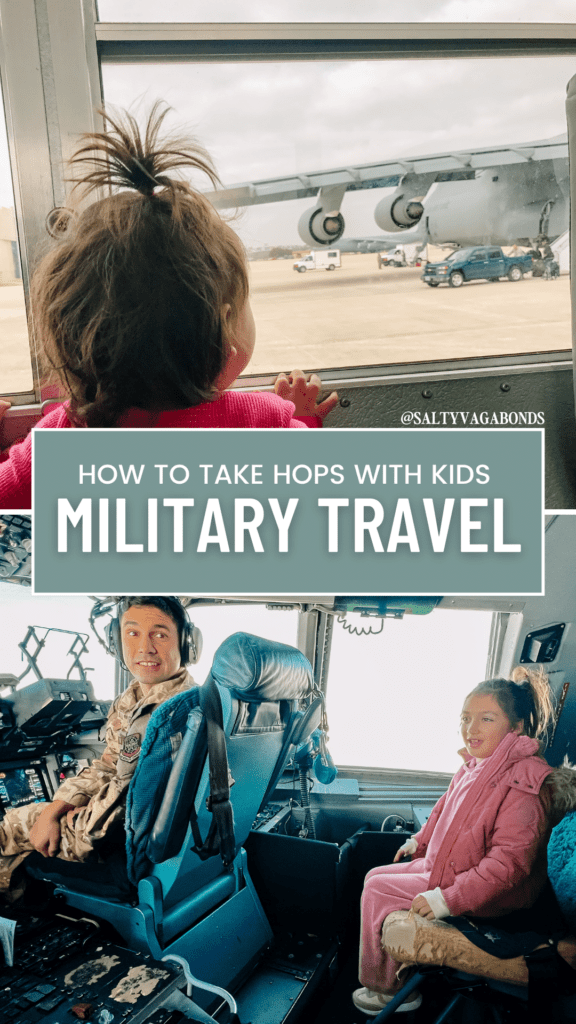


Leave a Reply Cancel reply
Our Story
Message in a
bottle?
Join our Newsletter! We're sharing monthly tips & tricks for travel, discounts & more.
Travel Blogs
About us
Contact
Tips & Tricks
hello@saltyvagabonds.com
Link in Bio
Work With Us
SpaceA Military Flights
Santa Fe Travel Guide
Visit Disney Aulani Hawaii
Family Packing Guide
Our Photography Gear
Plan Your Travel
See you soon!
Planning
Tips
Destinations
Oceania
North America
Europe
Asia
Bali
Japan
Korea
Malaysia
singapore
Thailand
Vietnam
France
U.K.
Germany
Canada
Mexico
usa
French Polynesia
Micronesia
Hawaii
Guam
Indonesia
All Travel Blogs
Destinations
Planning
Tips
Destinations
Travel Tips
Planning
About us
Hotels
via Booking.com
Car Rental
Book a Bus/Train/Transfer
Find Cheap Flights
Get ESIM or SIM Card
Easy Currency Exchange
Book Tours & Attractions
Get Travel Insurance
via Discover Cars
via Skyscanner
via 12Go
via Wise
via Viator
via Visitors Coverage
via SimOptions
